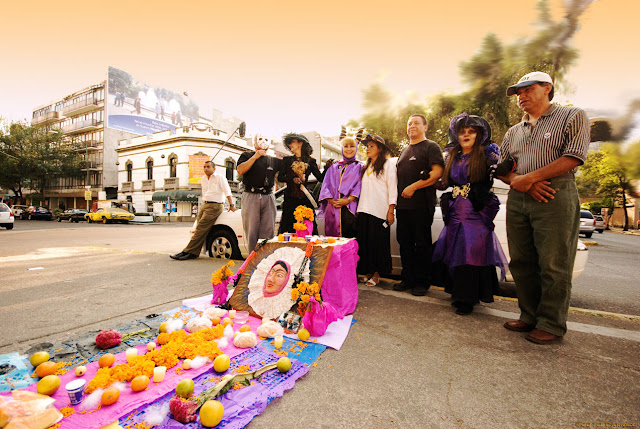

The Danza de los Voladores de Papantla (Dance of Papantla's flyers) is a ritualistic dance in Veracruz, Mexico performed by the Totonac Indians. Five men, each representing the five elements of the indigenous world climb atop a pole, one of them stays on the pole playing a flute and dancing while the remaining four descend the pole with a rope tied by one of their feet. The rope unwraps itself 13 times for each of the four flyers, symbolizing the 52 weeks of the year.
This dance is thought to be the vestige of a pre-Hispanic volador ritual common not only in ancient Veracruz but in western Mexico as well.
According to legend, a long drought covered the Earth so five men decided to send Xipe Totec, the God of fertility a message, asking them for the rain to return. They went to the forest and looked for the straightest tree, cut it, and took it back to their town. They removed all branches and placed it on the ground, then dressed themselves as feet/birds and descended flying attempting to grab their God's attention [
Wiki].
El Juego del Volador es una tradición mexicana que, para algunos antiguos pueblos indígenas como los olmecas y totonacas, era un ritual sagrado con un gran significado astronómico y religioso. También se práctica en el occidente de Guatemala. Consiste en que cuatro personas (simbolizando los cuatro puntos cardinales) se atan a un tronco alto y giran colgados alrededor de él 13 veces cada quien, sumando en total 52 vueltas, que eran los años que duraba un siglo astronómico para los indígenas. Aunque se suele conocer como Danza de los Voladores de Papantla, la evidencia arqueológica ha demostrado que se trata de un ritual muy antiguo y no circunscrito a la cultura totonaca. Se conocen representaciones de cerámica procedentes de Nayarit que parecen probar que el ritual existía por lo menos desde el Período Preclásico de Mesoamérica. En la actualidad sigue siendo celebrado por los grupos nahuas y totonacos de la Sierra Norte de Puebla y el Totonacapan veracruzano. Algunos grupos de indígenas de esas regiones se han trasladado a diversos puntos de la República Mexicana, como el Museo Nacional de Antropología en la Ciudad de México, donde hacen una breve representación del ritual indígena. En la celebración acompañada de danzas y música se utiliza un tronco o "palo volador" donde se ajustan varias piezas: una pequeña base, una cruz, un pivote que unirá y posibilitará el giro, y una escalera. En los extremos de la cruz se colocan cuerdas que sujetan a los danzantes voladores simbolizando los puntos cardinales, norte, sur, este y oeste. A más de 12 metros en lo alto de la estructura, se sitúa el caporal, personaje que toca un tambor y una flauta, y coordina el ritual. Cada señal que el caporal hace es un tipo de acrobacia, en una de ellas cada danzante volador disfrazado de ave saltan al vacío y giran 13 veces cada uno de ellos, con un total de 52, que representa los años que representaba un ciclo indígena. Finaliza cuando los participantes empiezan a abrir el circulo hasta tocar el suelo.
Gracias por su visita / Thanks for visiting.


















































